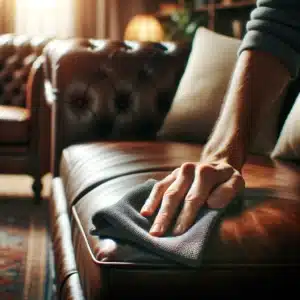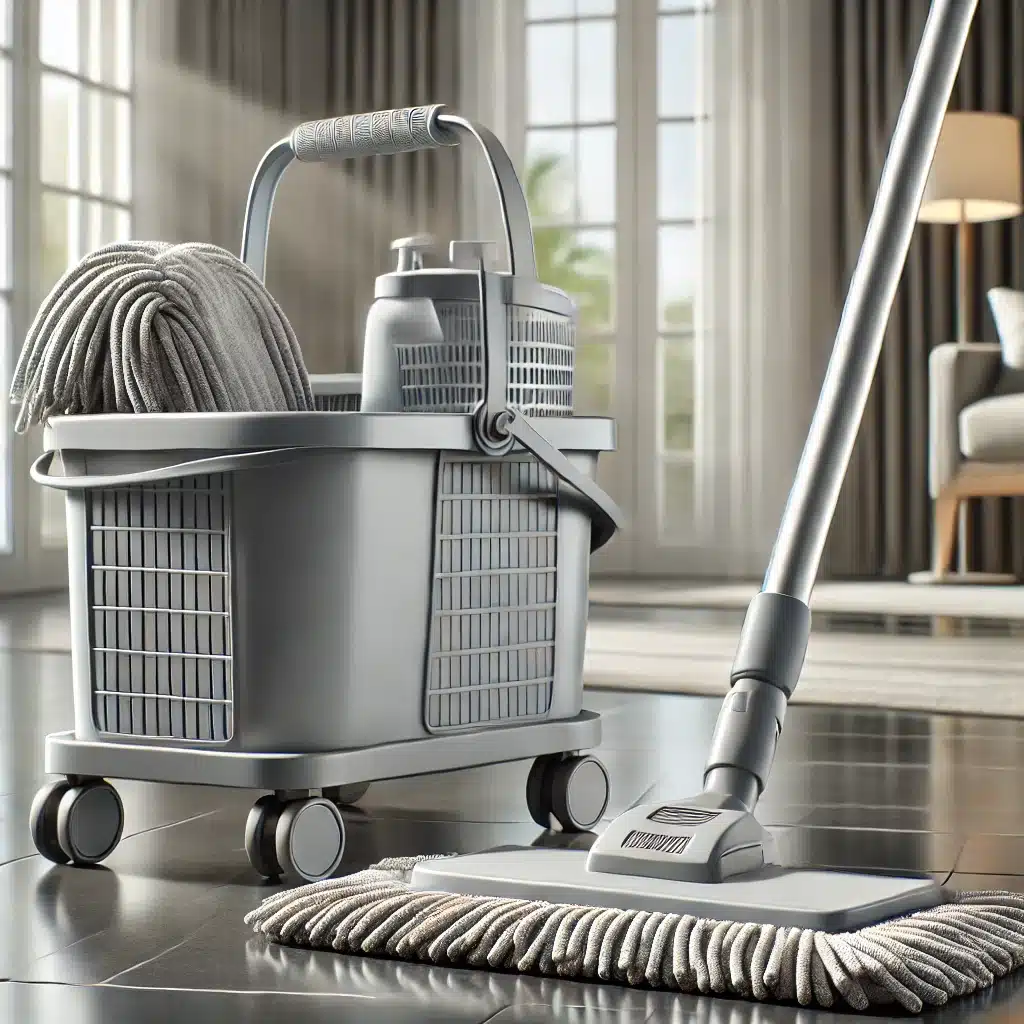Keeping your couch clean isn’t just about maintaining its appearance—it’s also about extending its lifespan and ensuring your living space remains healthy and comfortable. Whether you’re dealing with dust, spills, or just regular wear and tear, here’s a simple guide on how to clean your couch like a pro. Grab your cleaning supplies, and let’s dive into these five easy steps!
Step 1: Vacuum Thoroughly
When you start, take off all the cushions to expose the entire surface and underlying areas that often collect the most dust and debris. Using the upholstery attachment on your vacuum cleaner is the best way to ensure you’re not only removing surface dirt but also getting deep into the fabric where dust and small particles gather.
Focus particularly on the seams and crevices of your couch. These areas can trap larger particles that not only affect the appearance of your couch but can also wear down the fabric over time. Make sure to pass over these areas multiple times from different angles to ensure you’re extracting as much dirt as possible.
This meticulous approach to vacuuming lays the groundwork for a deeper clean, ensuring that when you move on to addressing stains or using liquid cleaners, your couch is free from any loose contaminants that could spread or seep deeper into the upholstery. By maintaining this routine regularly, your couch will not only look cleaner but also be a healthier component of your living space.

Step 2: Check the Cleaning Codes
Before you apply any cleaning solution, it’s important to locate and consult the manufacturer’s tag that contains the cleaning code. This code is essentially a guide that tells you what cleaning products and methods are deemed safe for your couch’s fabric.
The tag will typically feature one of the following codes: W, S, WS, or X. A ‘W’ signifies that your couch should only be treated with water-based cleaning solutions. This is common for many fabric types that can handle moisture but might be sensitive to chemicals. If the tag shows an ‘S’, it means that only solvent-based cleaners are appropriate. These are usually needed for materials that might discolor or degrade with water.
For those couches labeled with ‘WS’, you have more flexibility, as both water-based and solvent-based cleaners are safe to use. This is handy for versatile cleaning regimens, accommodating various types of stains and upkeep. Finally, a tag marked ‘X’ advises that you should neither use water nor solvent-based cleaners; these couches should only be vacuumed or brushed gently to avoid fabric damage.
By familiarizing yourself with these codes, you can ensure that you’re choosing the right products and avoiding any methods that could potentially harm the upholstery on your couch. Understanding and following these guidelines will help maintain the look and integrity of your couch, ensuring it remains a central, cherished piece in your home for years to come.
Step 3: Spot Clean Stains
When tackling visible stains on your couch, spot cleaning is an effective method to address these blemishes without the need for a full wash, which can be time-consuming and sometimes risky depending on the fabric type. To start, identify the type of fabric and refer to the cleaning code you checked earlier. This will determine the kind of cleaner that is safe to use on your couch without causing any damage.
When you’re ready to begin the spot cleaning process, apply just a small amount of the chosen cleaner to a soft, clean cloth. It’s important to dab gently on the stain rather than rubbing it. Rubbing can not only spread the stain but also work it deeper into the fibers of the fabric, which complicates the cleaning process and can permanently integrate the stain into your couch.
For those who prefer using natural cleaning solutions, baking soda is an excellent option for absorbing grease and odors, while a diluted vinegar solution can help lift more acidic stains. These natural cleaners are particularly handy for couches marked with ‘W’ or ‘WS’ codes, meaning they can handle water-based cleaning solutions. After applying your chosen cleaner, allow it to sit for a few minutes to break down the stain molecules. Then, gently blot with a dry cloth or paper towel to absorb the cleaner and lifted dirt.
This careful attention to the type of stain and the specific cleaning approach not only preserves the integrity and appearance of your couch but also enhances its longevity by maintaining its pristine condition.
Step 4: Wipe Down and Freshen Up
If the fabric of your couch is suitable for water-based cleaning agents, as indicated by a ‘W’ or ‘WS’ on the manufacturer’s tag, you can create a gentle cleaning solution. Simply mix a small amount of mild detergent with warm water. This solution should be mild enough to avoid damaging the fabric but effective enough to cleanse thoroughly.
Using a soft cloth, which is gentle on the fabric, begin wiping down the entire couch. It’s important to wring out the cloth well to avoid saturating the couch with too much water, which can lead to moisture-related issues and potentially damage the fabric. Ensure you cover all areas, including the back, sides, arms, and all cushions, with smooth, even strokes to lift dirt and reduce any existing stains gradually.
Following the cleaning, it’s time to freshen up your couch and tackle any odors that have accumulated. Sprinkle a generous amount of baking soda over the entire surface of the couch. Baking soda is known for its excellent odor-absorbing properties and is safe for most couch fabrics. Allow the baking soda to sit on the couch for about 20 minutes. During this time, it will absorb odors and even pull out some of the moisture that might have settled into the fabric from daily use or the wiping process.
Finally, vacuum off the baking soda thoroughly using the upholstery attachment. Make sure to go over the entire couch to ensure all residue is removed. This step not only clears away the baking soda but also any last traces of dirt and odors that were lifted by it. This thorough cleaning and refreshing process will leave your couch looking clean, smelling fresh, and feeling more comfortable. By incorporating these cleaning habits regularly, you can maintain the aesthetic and hygienic quality of your couch, making it a cozy and inviting focal point in your home.

Step 5: Dry and Refresh
In the final step of cleaning your couch, it’s essential to let it dry thoroughly. This process involves patience but is crucial to prevent any mold or mildew from developing due to moisture. After you’ve cleaned your couch, especially if you’ve used any water-based cleaning solutions or spot treatments, allow it to air dry in a well-ventilated area. Ensure that all parts of the couch, including cushions and areas between the seams, are completely dry. Avoid the temptation to use direct heat sources like hair dryers or portable heaters, as these can unevenly dry the fabric, potentially causing it to shrink or develop unsightly water stains.
Once your couch is entirely dry, it’s a great opportunity to give it a final touch-up to make it feel and smell even fresher. Lightly spray a fabric freshener across the surface of the couch. Choose a freshener that is suitable for your couch’s fabric type and consider opting for a scent that complements the overall atmosphere of your home. This will not only leave your couch smelling clean and inviting but will also help eliminate any residual odors that might have been missed during the cleaning process.
Applying a fabric freshener can also enhance the overall ambiance of your living space, making your couch more inviting. With these steps completed, your couch is now fully refreshed and ready to be enjoyed again. Regularly allowing your couch to air out and refreshing it with a suitable fabric freshener can significantly contribute to maintaining a clean, pleasant, and welcoming home environment.
Cleaning Couch Easy as Never!
By following these five simple steps, you can ensure that your couch remains spotless and in top condition. Regular maintenance is key to prolonging the life of your couch, ensuring it remains a cozy and inviting spot for your family and guests for years to come. Keeping up with routine care such as vacuuming, spot cleaning, and freshening up helps to prevent the buildup of dirt and odors that can lead to more serious issues over time.
However, there are occasions when a deeper clean might be necessary, especially when dealing with stubborn stains, or if your couch has not been cleaned for an extended period. In such cases, it’s beneficial to call in the professionals. Professional cleaners have the tools, expertise, and cleaning solutions that can effectively tackle tough stains and restore your couch to its original condition without risking damage to the fabric.
For those residing in the Toronto area, consider reaching out to a reputable service like Cleaning Hive. They offer a range of cleaning services that include deep cleaning for upholstery, ensuring your couch receives the care it needs. Their experienced professionals use eco-friendly products and advanced techniques to remove deep-seated dirt and allergens, making your couch not only clean but also hygienic.





